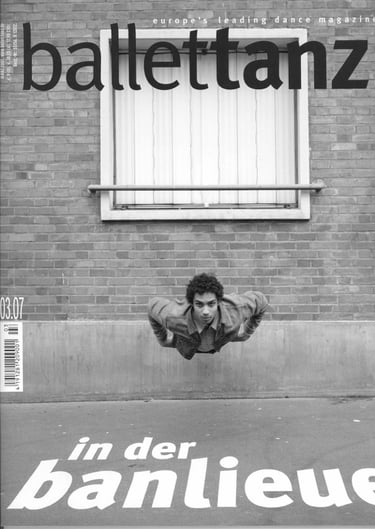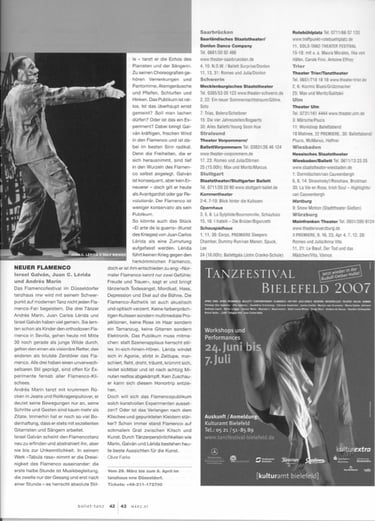PRESS

2025
Febrero
“Lérida se transforma”. Sara Esteller
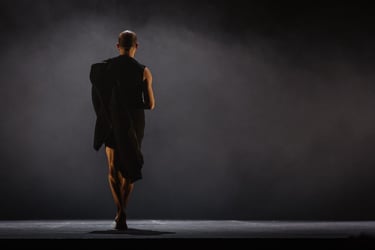

Marzo
Revista Entreacte “La dansa d’arrel està de moda”
https://entreacte.cat/dansa/la-dansa-darrel-esta-de-moda/
“Un quejio flamenco en las entrañas del bosque”
https://saraesteller.com/2025/03/27/embolismoporsolea/
Abril
Sobre CHER.
Primavera Sound.
https://www.youtube.com/watch?v=JfQbw-g2q-w
Tea-tron. “Cavar hacia dentro” por Sara Manubens.
https://www.tea-tron.com/mercatflors/blog/2025/04/02/cher-cavar-hacia-adentro/
CRITICA
Nuvols. Por Oriol Puig Taulé .
Flamenc desconstruït i amb autotune
https://www.nuvol.com/teatre-i-dansa/dansa/flamenc-desconstruit-i-amb-autotune-426727
La Era Cher. Susy Q.
https://susyq.es/actualidad/2415-j-c-lerida-mercat-de-les-flors
Mayo
“Embolismo por soleá” junto a Paula Bruna y laboratorio de investigación desde el flamenco
https://susyq.es/actualidad/2447-paula-bruna-festival-10-sentidos
Junio
“Te miro y me veo” junto a Amalia Fernández
https://revistagodot.com/componer-y-escucharse-en-este-instante/
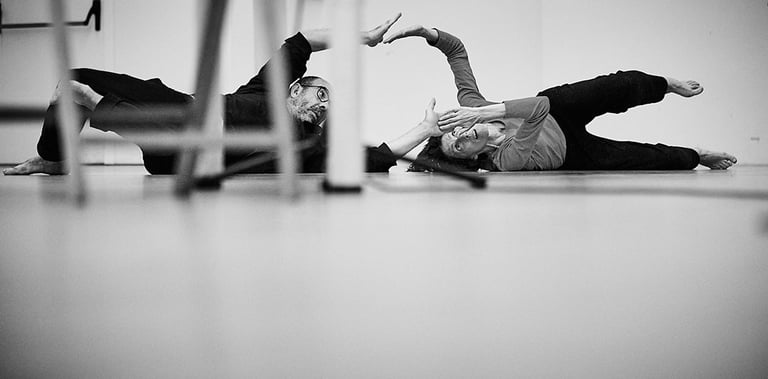

La marea y el reparo. Festival Conil. Cádiz
Julio
Fira mediterranea Manresa. 2025
https://www.b-ritmos.com/28a-fira-mediterrania-manresa-2025/

2024
Febrero
Revista la flamenca .“La contemporaneidad en el baile flamenco” por María de Los Ángeles Cenizo
https://www.revistalaflamenca.com/la-contemporaneidad-en-el-baile-flamenco/
Abril
Serra d’or. Entrevista realizada por Salvador S. Sanchez junto a Carmen Muñoz
Noviembre “El flamec a catalunya s’autodeterminarà”
https://www.pamsa.cat/serra-dor-772-abril-2024/
Culturopolis. Mundos paralelos. Laboratorio de investigación desde el flamenco
https://www.barcelona.cat/culturopolis/ca/programacio-artistica/19-novembre
Julio
SOMIT: converses amb els nostres docents», Conversa entre el ballarí i coreògraf Juan Carlos Lérida i l'escenògrafa Xesca Salvà

2023
LIBRO «EL MÉTODO FLAMENCO EMPÍRICO»
Reseñas:
Presentaciones.
Presentación del libro en Valencia . Europa press
Penmarch. Bretaña ( Francia) 11 agosto
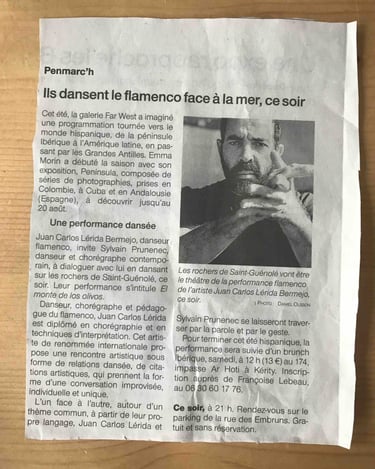

Improvisación sobre las rocas con Sylvain Prunenec
Libro «El método flamenco empírico»
Entrevista «A compás RNE». Olga Baeza
Festival Esdansa
https://www.nuvol.com/teatre-i-dansa/dansa/joves-i-arrel-a-esdansa-338002
Fira mediterránea. Manresa
Radio «Aixó és un drama»
https://www.ccma.cat/3cat/arts-esceniques-i-patrimoni-cultural-aliats/audio/1066663/
achtungmag
https://achtungmag.com/lorena-benot-la-gente-concibe-como-una-fiesta-al-festival-cadiz-en-danza/
Certamen coreográfico Madrid 2023
https://certamencoreografico.com/en/premiados-37o-certamen-coreografico-de-madrid/
Premiados 37º Certamen Coreográfico de Madrid
HERALDO. ES
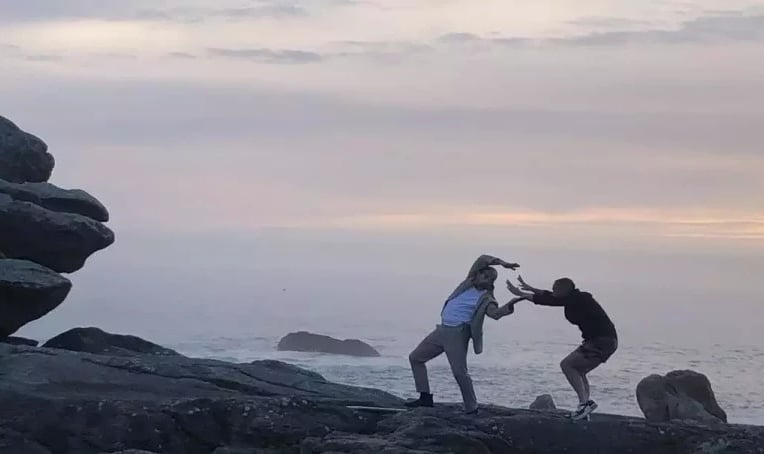


2022
MÁQUINAS SAGRADAS. FESTIVAL DANZA VALENCIA. 9 ABRIL 2022
Un Blog de danza / Mercedes L. Caballero.
24/7 Valencia / Julia McGee-Russell
IM FLAME. FLAMENCO FESTIVAL TANZHAUS 18 ABRIL 2022
http://www.flamenco-divino.at/festival-de-duesseldorf-im-flame/
MÁQUINAS SAGRADAS. CENTRO PARRAGA, MURCIA. 29 ABRIL 2022
LA HORA DEL RITUAL. DESVARIOS , FESTIVAL FLAMENCO NOU BARRIS 23 JULIO 2022
EL MONTE DE LOS OLIVOS. FESTIVAL VEJER FLAMENCO. 1 SEPTIEMBRE 2022
MÉTODO FLAMENCO EMPIRICO - ESPAI LA GRANJA. VALENCIA-4 NOVIEMBRE 2022
DOCE. ( Teatros del Canal- Madrid) 15-18 DICIEMBRE 22
Previas:
Entrevista:
https://susyq.es/actualidad/1699-juan-carlos-lerida-teatros-del-canaC
https://www.rtve.es/play/audios/a-compas/compas-loco-bne/6754838/
El País. Mercedes L. Caballero
Crítica:
DOCE . Teatros del Canal. Madrid

2021
LA LITURGIA DE LAS HORAS. Mercat de les flors
La vanguardia. «Juan Carlos Lérida baila 12 horas de «via cruces» flamenco itinerante.
El periodico «12 horas de peregrinación flamenca por Montjuic»
El pais » La pasión de cristo convertida en 12 horas de flamenco»
Teatron» Bienaventuradas las malas hierbas..»
Nuvols. com » Un Via Crucis en clau flamenca»
ccma.cat El mercat de les flors…..
El punt avui. «Anima flamenca»
SusyQ. Doce Horas de liturgia flamenca
Mercat de les flors. Uno al doce o como el cuerpo creador se va alejando de la escena
Mercat de les flors. El corazón en llamas.
El Pais.
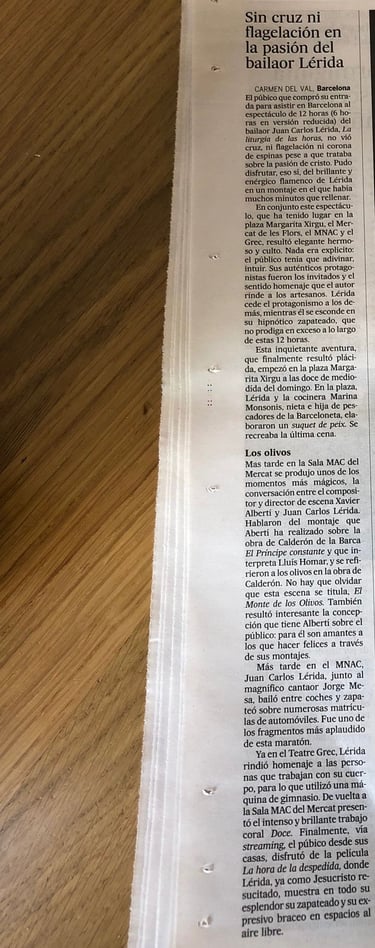

LABORATORIO DE INVESTIGACIÓN DESDE EL FLAMENCO.
la vanguardia » La Filmoteca impulsa el diálogo entre cine y flamenco con un espectáculo»
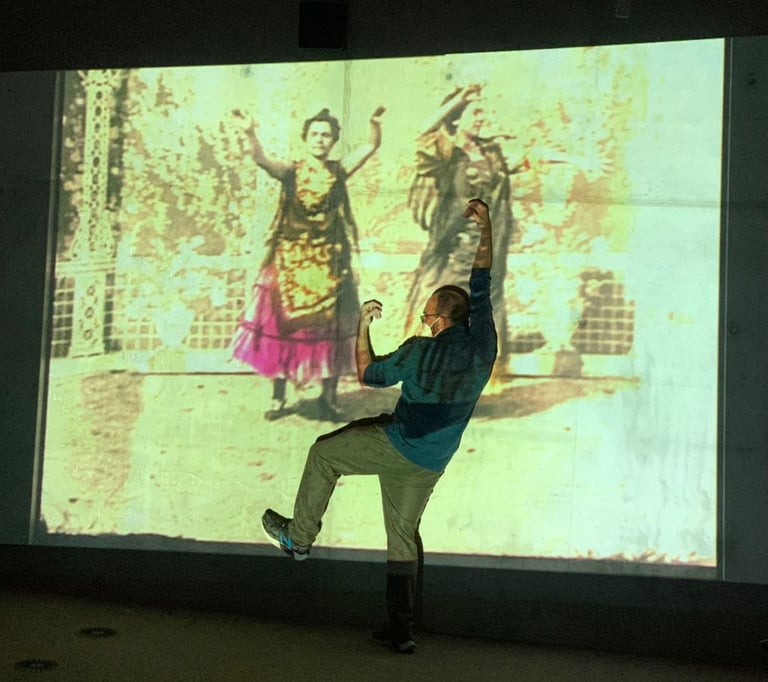

BTV. «Cine y flamenco dialogan con el flamenco»
Nuvol. «·Flamencos al laboratorio»
Marzo
https://www.youtube.com/watch?v=63FcEhaRRdM
Inauguración Dansa Metropolitana.
Telon de fons. Alacarta.cat, Inauguración de Dansa Metropolitana.
https://terrassadigital.cat/flamenc-i-cuina-es-fusionen-a-la-hora-del-ritual/
Ara.cat. 5 cites imperdibles del dansa metropolitana….
El Pais. Dansa Quinzena metropolitana cierra con 15.800 asistentes….
Barcelona.cat. Dansa metropolitana se consolida….
Crítica Máquinas Sagradas: Recomana.cat
Crítica Máquinas Sagradas: Nuvol.com
Crítica Máquinas Sagradas: El punt avui
LA OSCILANTE.
La Oscilante en Cádiz.
La Oscilante en Tenerife.
LABORATORIO INVESTIGACIÓN DESDE EL FLAMENCO.
Abril
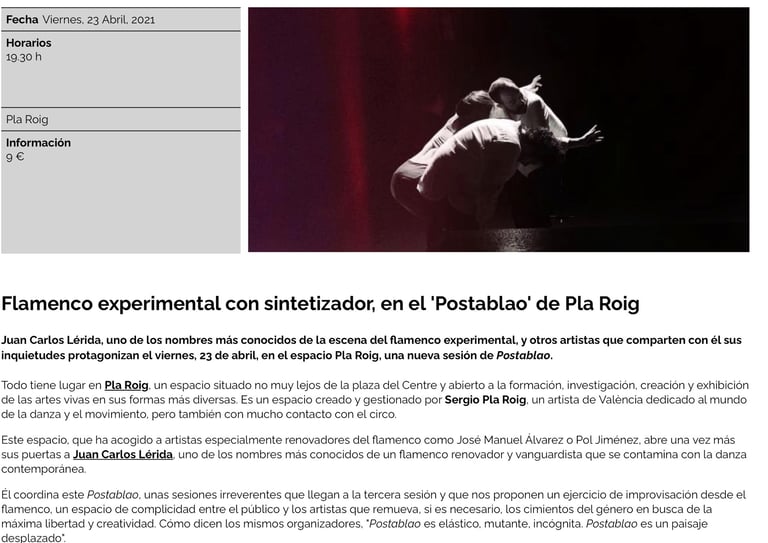


2020
LA HORA DEL SACRIFICIO. Sismograf Olot.
LA OSCILANTE- Barcelona.

2019
DOCE. Mercat de les Flors
Critica:
Telegrama Cultural. (El particular Via Crucis de Juan Carlos Lérida»
La Vanguardia: “Yo llevo puesto el filtro del flamenco en mi mirada sobre la vida”
El Punt Avui: «Viacrucis Flamenco»
Ara Cat: «Una crucifixió com a transformació i elevación»
La Vanguardia: El «hereje del flamenco» Juan Carlos Lérida se inspira en Jesucristo.
El Pais: La danza mirando de Reojo.
LA OSCILANTE
LA OSCILANTE EN FIRA MEDITERRANIA DE MANRESA.

2018
4 Abril 2018. Barcelona.
«Again the magic of Constanza. She wanders around gravityless, filling the space and strongly capturing your attention with her intense expressiveness. Accompanied this time by Juan Carlos Lérida, a nice surprise, especially when performing tap dance. De luxe musical sountrack by two known masters, able to use their instruments in unexpected, and unusual ways. A real privilege to ba able admire this sort of performance in the very short distance«
20 Abril. Olot- Girona
Bailarin invitado en MOL·LECULARI- Lipi Hernández
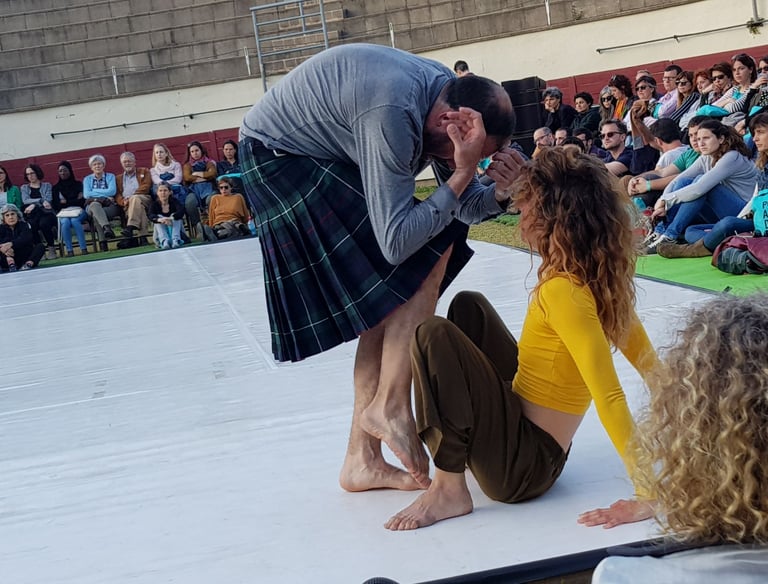

4 Abril 2018. Barcelona.
«Again the magic of Constanza. She wanders around gravityless, filling the space and strongly capturing your attention with her intense expressiveness. Accompanied this time by Juan Carlos Lérida, a nice surprise, especially when performing tap dance. De luxe musical sountrack by two known masters, able to use their instruments in unexpected, and unusual ways. A real privilege to ba able admire this sort of performance in the very short distance«
20 Abril. Olot- Girona
Bailarin invitado en MOL·LECULARI- Lipi HernándezPunt Avui- La erupción penetra. Jordi Bordes.
«…També Lipi Hernández parteix d’una peça introspectiva. Aconsegueix sumar en un mateix treball veus amb tanta personalitat com Laila Tafur, Juan Carlos Lérida i Manuel Rodríguez (tots tres amb universos propis com la dansa performàtica, el flamenc contemporani i el moviment KOVA dels de La Veronal, respectivament) per incitar-los a formar part d’un mateix caos. Mol·leculari transmet, des d’una notable abstracció, la relació entre l’individu i el grup: com una idea d’un ballarí transmuta en els cossos dels altres….»
RECOMANA.CAT. Trabajo de Grupo- Jordi Sora.
«….Mol·leculari demostra la profunditat del punt de partença: perquè és la participació (prendre part, no pas ser una part) en què se sosté. I no pas per deixar de remarcar amb aquest exercici l’alta qualitat de cadascú dels seus integrants. Tot el contrari: la profunda expressivitat d’Álvaro Esteban; el dinamisme de Dario Barreto; la intospecció de Janet Novas; l’elegància gestual de Laila Tafull; la solvència interpretativa de Juan Carlos Lérida; la tensió de Manuel Rodriguez; l’explositivitat de Raquel Klein. Totes elles, tots ells són ben presents en cada fragment de l’obra; de la mateixa manera com només prenen sentit perquè responen a un interès como….»
RECOMANA.CAT. Aprender ser el otro. Montse Otzet
«…Mol·leculari, coproducció del Festival Sismògraf, compta amb una durada precisa de 45 minuts, suficients per mostrar tot allò que la directora i els set ballarins volen exposar i desenvolupar sobre el desbordament dels límits dels maateixos cossos, sobre el fet de demostrar que el fet múltiple també esdevé part d’una unitat, sobre el vincle constant d’un cos individual que entra a formar part d’un organisme comme. Alvaro Esteban, Dario Barreto, Janet Novas, Laila Tafur, Juan Carlos Lérida, Manuel Rodríguez i Raquel Klein, ballarins de fisicalitat diferent i propietaris d’un bon bagatge professional, defensen de forma notable el contingut i el desbordament energètic i rítmic del muntatge…»
NÚVOLS- La gran família del Sismògraf- Oriol Puig Taulé.
«..A continuació ens vam dirigir a l’interior de la Plaça de braus, on Lipi Hernández presentava el seu Mol·leculari, una peça que explora la idea de grup. Si bé el plantejament és força proper a l’exercici, a l’experimentació a partir d’una idea (en aquest cas, la imitació de patrons de moviment), el gran nivell dels intèrprets és el que salva l’espectacle: comptar amb Laila Tafur, Manuel Rodríguez, Janet Novas o Juan Carlos Lérida és tot un luxe. Aquí i a la Xina Popular…»
LA VANGUARDIA. «Olot o el arte de la ‘sismodanza’- MARICEL CHAVARRÍA
«…Otro éxito ha sido el Mol·leculari de Lipi Hernández en la plaza de toros…»
24 Abril. Barcelona.
INSTITUT DEL TEATRE. Proyecto Laboratorio de investigación desde el Flamenco IT.
«…El professor del Conservatori Superior de Dansa (CSD), Juan Carlos Lérida, és al capdavant del projecte, el qual al llarg d’aquests mesos ha aconseguit establir diverses línies d’investigació sobre el flamenc, a partir de les quals s’han concretat interessants reflexions i s’han fet múltiples improvisacions i experimentacions entre els participants…»

2017
ENERO 2017
AL CANTE
«La Vibora desbocada» Niño de Elche. Por Nando Cruz.
«……Niño de Elche no dan la verdadera medida de un artista que estalla en toda su inmensidad sobre el escenario; sobre todo, en diálogo con creadores de otras disciplinas. Desde que en el 2011 se lanzó a la piscina de la heterodoxia con ‘Vaconbacon’, reinterpretando desde su posición de cantaor la obra del pintor Francis Bacon, no ha salido de ella. La evocadora ‘Al baile’, pieza del coreógrafo Juan Carlos Lérida, o los explosivos directos que ha presentado en el festival Sónarjunto a los videoartistas Los Voluble son dos de las muestras más excepcionales de su insaciable vocación exploradora»
FEBRERO MARZO 2017
PISADAS. CIA OLGA PERICET
Flamenco Festival Miami/ NY
«….Al día siguiente, domingo 12 de marzo, el New York City Center acogerá a las siete de la tarde el espectáculo Pisadas de Olga Pericet, con Juan Carlos Lérida como coreógrafo e intérprete invitado»
«………Pisadas (March 4), she is accompanied by her own group of singers and musicians, not to mention a special treat for flamenco fans: Seville dancer Juan Carlos Lérida, who’s loved by dance fans the world over for splicing that puro style with contemporary flair»
El Setinel South Florida. @Juan Carlos Pérez Duthie.
«…El flamenco se reinventa, una y otra vez, sin perder su espíritu andaluz. Eso siempre lo tiene en cuenta uno de los más audaces e intrigantes exponentes del género en los últimos años, Juan Carlos Lérida, cada vez más conocido en Estados Unidos…»
Agencia EFE. @Lorenzo Castro
«…… Lérida defendió que antes que un provocador o un radical, calificativos que le han granjeado su apuesta por lo que él llama un «flamenco empírico» y en la que caben la danza contemporánea y las técnicas de improvisación, él se considera «un confrontador»
«El coreògraf Juan Carlos Lérida balla a Miami i Nova York»
.».. En este contexto, el segmento titulado La fiera en el monte, creado junto con Juan Carlos Lérida, es una joya.»
«…y entonces aparecen los cuernos en escena. Juan Carlos Lérida vestido de tierra húmeda y salvaje porta el astado de un ciervo en una defensa monumental del arte y cuando aparece Olga le toca las castañuelas por debajo de las patas. Un gag que ríe el teatro entero. Otro gesto que retoma la narración mientras los músicos y los cantaores interpretan el garrotín y parece que se disipa la escena y vuelven al Lelolelolelode San Juan…»
OCTUBRE 2017
PISADAS. CIA OLGA PERICET
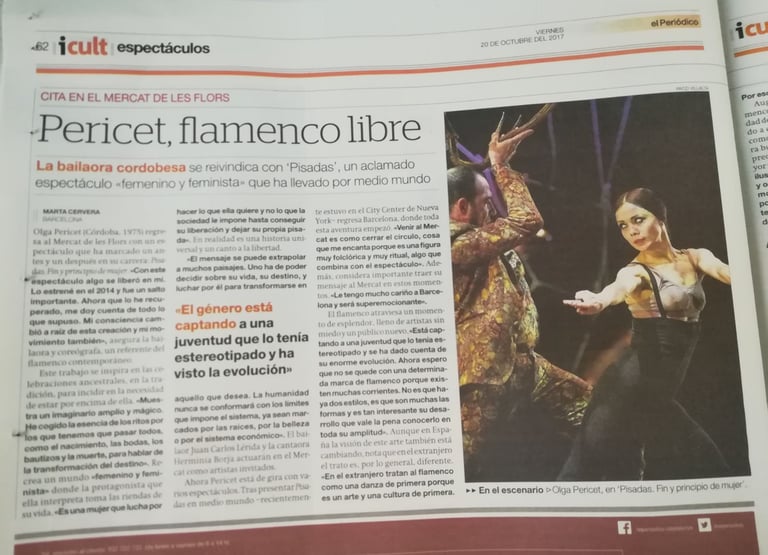

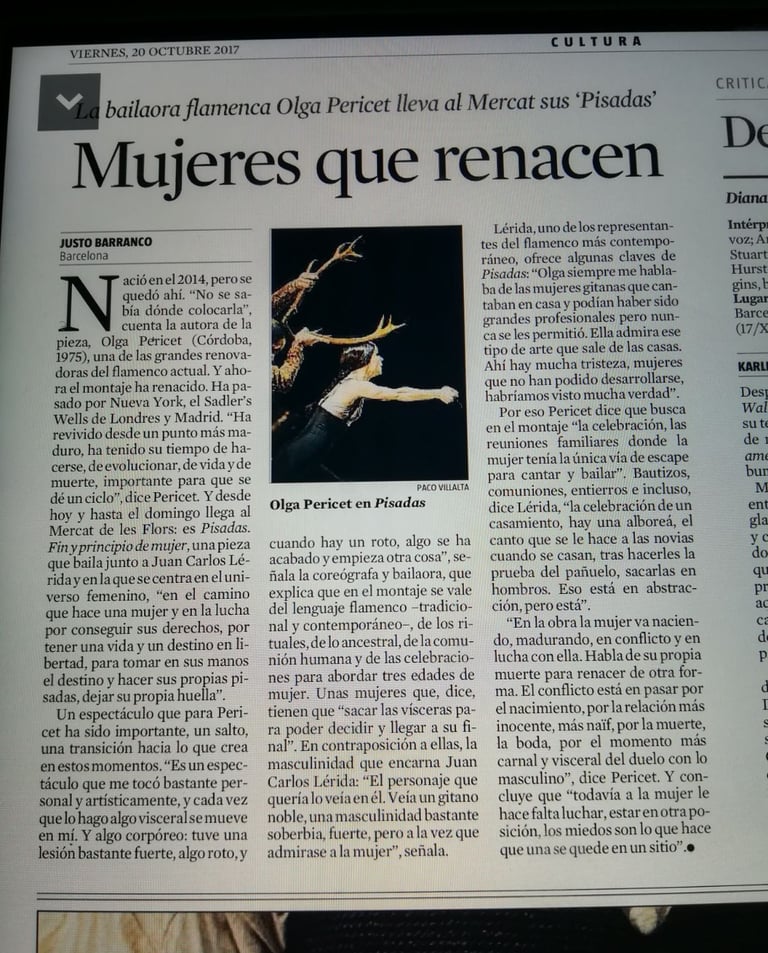

CRITICA EL PAIS – Carmen del Val.
«Uno de los momentos más brillantes de este montaje es el solo de Juan Carlós Lérida, una de las figuras clave del ciclo Flamenco Empírico del Mercat de les Flors y que el público recordaba por su magnífico trabajo Al baile.
El solo de Lérida es vanguardista y transgresor, su flamenco, en este caso, tiene un toque salvaje. Encarna la masculinidad y también los instintos animales del hombre. Luciendo unos cuernos de reno baila con una fuerza hipnótica al son del famoso palo El garrotín. Más tarde se unirá a su baile Olga en un desafiante enfrentamiento entre hombre y mujer en el que el primero será el vencedor»
CRITICA RECOMANA.CAT– Montse G Otzet.
«Un punt i a part mereix la presencia i interpretació que fa Juan Carlos Lérida del Garrotin, demostrant de forma impressionant que és un artista amb un ric món imaginari, que sap com trencar barreres per oferir un ball tan ortodox com fora d’òrbita. El pas a dos amb Olga Pericet, en què ell és un cérvol, és d’antología»
CRITICA EL PAIS. Patrícia Soley-Beltran.
«…Ella es la sorprendente bailaora cordobesa Olga Pericet; el dulce bailaor empírico, Juan Carlos Lérida, la bestia. Hay riesgo: estamos fuera de las reglas de convivencia pactada entre humanos. Hay tensión: se movilizan fuerzas subconscientes. Hay peligro: ¿morirá alguien? La desproporción de tamaño y fuerza atemoriza a todos… menos a ella. Ella ni se arredra ni se deja dominar, porque este no es el juego que desea, sino el juego que debe aceptar..»
NOVIEMBRE 2017
AL BAILE
MAS JEREZ. David Montes
«….Esta trilogía me ha ayudado a visualizar el flamenco desde un prisma contemporáneo…”.
ABC. Marta Carrasco.
«…Juan Carlos Lérida es un artista que trabaja desde hace años dándole una contemporaneidad al flamenco. Así, con «Al Baile», concluye la trilogía de «Los cuerpos del flamenco», completada con «Al toque y Al cante», con la que el creador ha buceado por la gestualidad flamenca En «Al Baile» Lérida hace de su propio cuerpo, injertado en otros cuerpos ajenos al flamenco, un campo de investigación, afanándose en encontrar, como un buscador de metales preciosos, el baile en cada uno de sus órganos. «Hay danzas de piel, de carne y de huesos…».
DIARIO DE SEVILLA. Braulio Ortíz. (Entrevista)
«La liturgia de la Carne»
CORREO DE ANDALUCIA. Dolores Guerrero. ( Critica/ Review)
«Y el proceso se hizo Cuerpo».
DIARIO DE SEVILLA. Juan Veranillos. ( Critica/ Review)
«Tetosterona rosa contra los límites».

2016
AL BAILE
Danza.es: Juan Carlos Lérida cierra su trilogía con ‘Al Baile’
La Vanguardia: Lérida cierra su investigación sobre el cuerpo en el flamenco con «Al baile»
Vilaweb: El ‘bailaor’ Juan Carlos Lérida torna l’espontaneïtat al ball flamenc
Reseña Web Entrebambolinesblog
Barbara Raubert para Mercat de les Flors. Blog.
«La plasticidad de un Flamenco»
Jordi Sora para Susy Q Magazine. nº 60. 2016
Punt Diari ( Barcelona) por Jordi Bordes.
Reseña/ Diario de Terrassa ( Barcelona) por José Antonio Aguado. 26 Octubre 2016
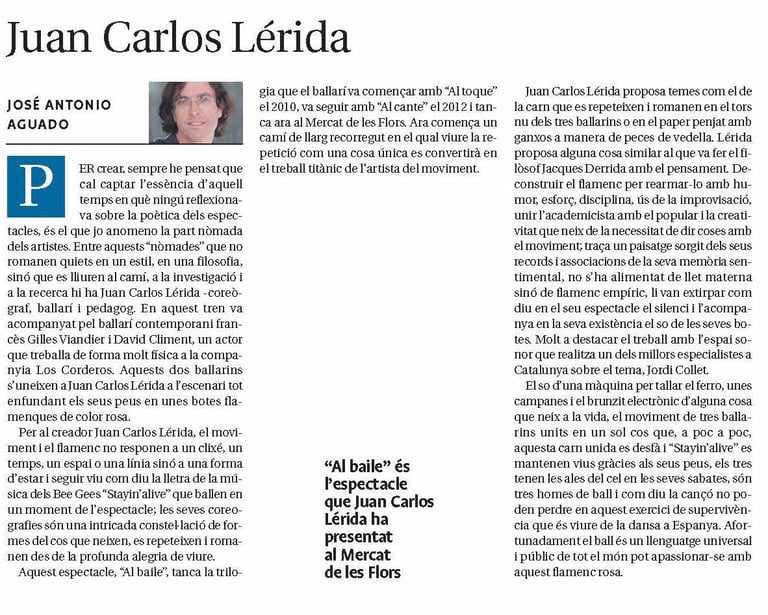

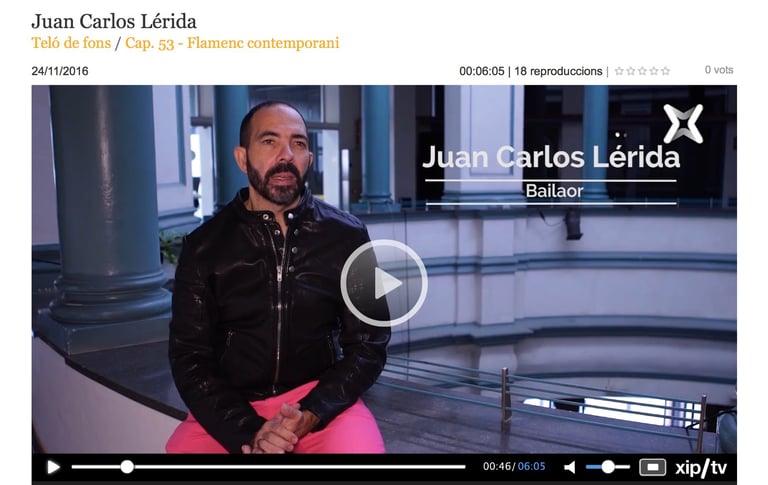

MIAMI
MIAMI HERALD. BAILOGRAFÍA- OUT IN THE TROPIC.
TANZ MAGAZINE JUNIO
ENTRAR AL JUEGO. CIA MARCO FLORES
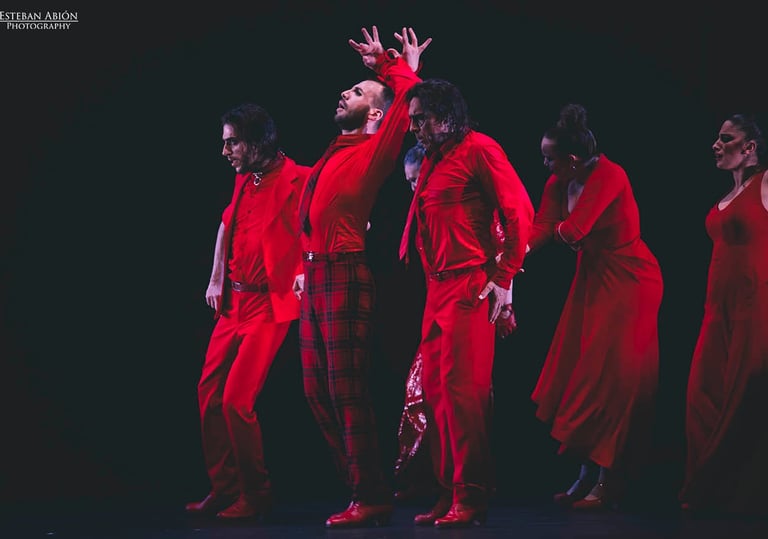


2015
Showcase in Centro Cultural Español en Miami.
Record by Canal Arte Mundo Latino.
REVISTA EL ESTADO MENTAL. Mayo 2015
Texto: Silvia Cruz Lapeña
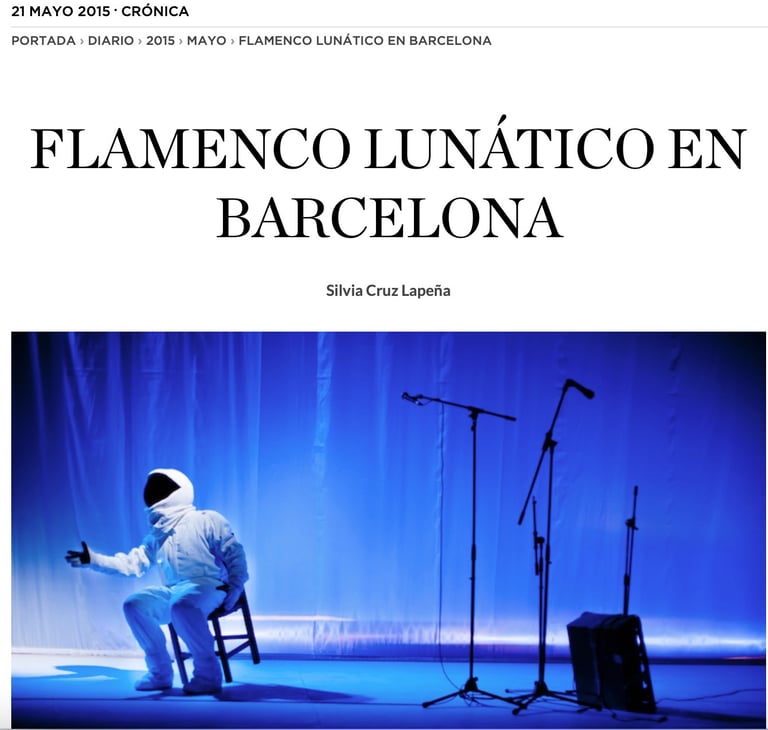


2013
ANDA MAGAZINE
Nº103 Oct/Sep 2013
Text: Susanne Zeilinger
Photo: Ralf Bieniek
CANTE
REWIEW/ CRÍTICA:
MERCAT DE LES FLORS. FESTIVAL CIUTAT FLAMENCO. BARCELONA.MAYO 2015
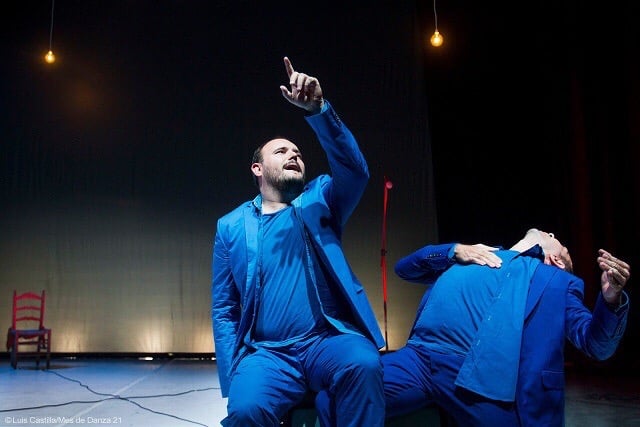

Mes De Danza. Tnt. Sevilla. Noviembre 2014
Reseña de Mercedes L. Caballero. http://unblogdedanza.com/2014/11/06/clase-magistral-de-flamenco-avanzado/
MOUVEMENT.NET. ( Carolane Sánchez) English Traslation:
A new generation revisits Flamenco dogmas. With the recent creation of Al Cante, Juan Carlos Lérida focuses on the emblematic figure of flamenco singer (Cantaor).
For over twenty years ago, Juan Carlos Lérida is an avan-garde artist of Flemish art scene. Transgressor,for his constant perceptive reassessment of nervousness of this genre, the artist faces today in his latest piece to a priesthood of the historical construction of Iberian art: Flamenco cante, and by extension, that which supports, makes breathing and gives «body» the figure of the «cantaor» Whit Al Cante (referring to flamenco), Juan Carlos Lerida passed to a second stage in his project to revisit the structural foundations of flamenco: triptych guitar-sing-dance.This new piece indeed happens to «Al Toque» (2010, title referring to flamenco guitar), where, with guitarists José Luis Rodríguez and Marta Robles, Juan Carlos Lerida localized flamenco guitar in the middle of his questioning. Through revisiting the standards of the Spanish guitar, body dialogues operating: the instrument exercised a centripetal force framed by the relationship between the dancer and guitarists.This search paved the way for the re-appropriation of Flemish elements generally sidelined being static on a physical level. Today it’s time for the flamenco being incorporated into the study of the trajectory of the «bailaor». Developed on a laboratory table leridiano «al cant jondo» is indeed the least moved in the last thirty years,contrary the revolutions in dance operated by artists like: Belén Maya, Israel Galván, Andrés Marín, Rocío Molína, etc. Juan Carlos Lérida, free electron but also intrinsic figure of this generation, today shows the result of an investigation carried along with the actor and playwright David Montero (whose piece Guests, directed by Belén Maya, has just been awarded by the critics of Jerez festival) and Francisco Contreras Molina cantaor, whose stage name is Niño de Elche, singer of the younger generation, which has become famous for its flamenco revisit the works of painter Francis Bacon with his piece VaconBacon.Cantar las Fuerzas (Singing Forces) (2012). Following a long process of experimentation, the three presented in Dusseldorf, within the Flamenco festival Tanzhaus, on April 17, 2014, the debut of «Al Cante». With this piece, is the backbone of flamenco which opens to the reflexivity of its construction, relief,et who questions his own motivations. El cante is open to other audio jacks because finds, this time, naked of any reference and expectation. It gives to be noticed, seen in his carnal manifestation. While Niño de Elche sings, Juan Carlos Lérida reacts to his movements, gestures, habitus of singer, wich made part of the gestural vocabulary understood by fans of flamenco, such as finger raised in the air in reference to Seville singer Antonio Mairena, or expressions of distortion mouth echoing the flemish singer Agujetas. The voice of david Montero says almost naturalistically, minimalist, distanced, details that operate on the body of Niño de Elche, interpreted according to different clubs.Juan Carlos Lérida, plays, surround, observed, returns, passes the object of study. All care is performed on the traces left flamenco Cante who recites the vector, the route, the cantaor finally. To image of Federico García Lorca, and his verses addressed to the moon, flamenco cantaor seen by leridiano universe is transported into space. Juan Carlos Lérida wearing a suit cosmonaut in a moment of the piece, made us in watermarks this question: would Happen if the last surviving Cantaores was sent to the moon to preserve knowledge of flamenco? Under this scheme, first funny, the skeleton of a piece as both poetic review is drawn.Mocking the close relationship of Flamenco with the archival dimension, abit speech rating, to complain about what is still flamenco and what is not. That Flamenco or amateur who has not heard these famous tiptoe: «when does the «solea» not know what … «; «Now that’s flamenco …», «it is not» … etc.. The space between flamenco and dogma is indeed sometimes narrow, but seeks to open.Juan Carlos Lleida search continues the dismantling of a genre that is diffracted and deployed in multiple ways. The reflections are then projected tracks to rethink the set, so called immutable, it seems important not judgment, but putting the relief of the gear mechanisms play in the writing of art history.
STIMBEGZEITUG (Von Klaus Lipinsky) English Traslation:
Flamenco Festival. Aufs Wesentliche reduziert. Von Klaus Lipinski
21. April 2014, 14.41
Reduced to the essentials
Dusseldorf. The moon. Hardly a romantic metaphor is more commonly used. Also in flamenco. So you can also make it to the stage. This
thought in any case Juan Carlos Lerida, the great avant-gardist among Flamenco dancers. As a rather unromantic artist, he debunks stereotypes, outdated ideas in a scientific reality. How the moon. At the Dusseldorf Flamenco Festival he showed the world premiere of his new piece «Al Cante» in which he examines singing and singers from within and without. Ten days Flamenco fans came from all over Germany and Europe for courses and performances in dance house NRW. Because once again taught famous dancers in person. Lerida also would be a great dancer outside of flamenco. He discoveres slowness as part of his movement intensity, uses small gestures in order to achieve their own way for very poetic effect. A dancer who is able to phrase his movements without music as a good singer. Traditional Flamenco is just an additional possibility of expression for Lerida, but one with a very strong force. He likes to split it into its components, such as when rhythms are beaten only by hand. Silence at the beginning. Yet the movements are not more than a mimetic imitation of singing, they will quickly become an emotional interpretation, a visible representation of the intensity, which reflects the movements of the singer, and he finally pretends by counting the rhythm. . A convincing concept for an increase with a surprising result: The singer himself became a dancer. Nino de Elche sets past all the prescribed flamenco poses. He does not loose emotions, but gaining of expression. Not in the background, but as a partner on the same level. Antonio Mairena was seen as silent projection in the background. The famous conservative keepers of flamenco, who was opposed to any renewal of flamenco. What a contrast, and how much gain Lerida and de Elche from today’s perspective the comparison.
(Extract) ….the show goes beyond the poetic in dance or gestures. Immerse in the narrative with a succession of scenic entrances, a bit like the clowns even if performance is more accurate.
Josep Ache, Diari de Sabadell 09.04.2015
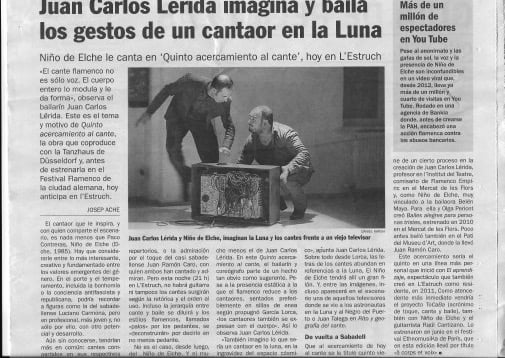

TANZ.AT (Edith Wolf) English Traslation:
Im Raum Flamenco: Lérida und Maya; 6.8.2013
A space for the experiment. Looking for new ways in traditional flamenco, the arists of the first edition of the festival «Flamenco in space», which feels especially obliged to contemporary and experimental forms. Dancing and singing was the focus – so consequently it has become the motto of the event.
Easy going, carefree and refreshing Juan Carlos Lerida and Francisco Contreras, «El Nino de Elche» and the actor and playwright David Montero disassemble the much celebrated moon and at the same time the formal language of flamenco. In the space suit Lerida simulates weightlessness while Contreras tests how the voice could probably sound in space. Now the moon is deprived of his romantic connotation, because now the moon drivers have a view down to the inflated balloon-earth and play football with it. And when it comes to the moon, of course, the TV may not be missing, as an element of percussion, stage and set piece ….. In the partly improvised performance, the third approach to the singing (original title: “3° acercamiento al cante”) of the trio after initial bewilderment («where’s the Flamenco?») it comes to an entertaining ease. Lerida, Contreras and Montero develop the piece along a rhythm that like this probably can come only from the Spanish dance – and of course there is also in this radically deconstructed flamenco show one or the other Zapateado, one or the other singing part, percussion and palmas including, supplemented by music from the band.
……….
ANDA MAGAZINE
Nº 110 Oct/Nov 2013
Text: Anja Abels
Photo: Daniel Karsch
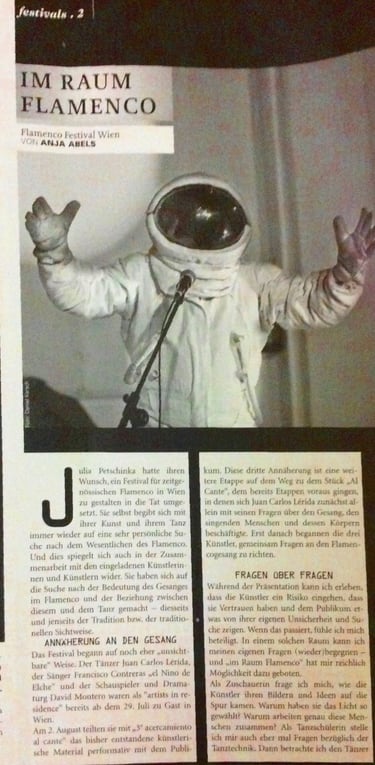

ANDA MAGAZINE
nº 114 Jun/July 2014
Text: Oliver Faker
Photo: Ralf Bieniek
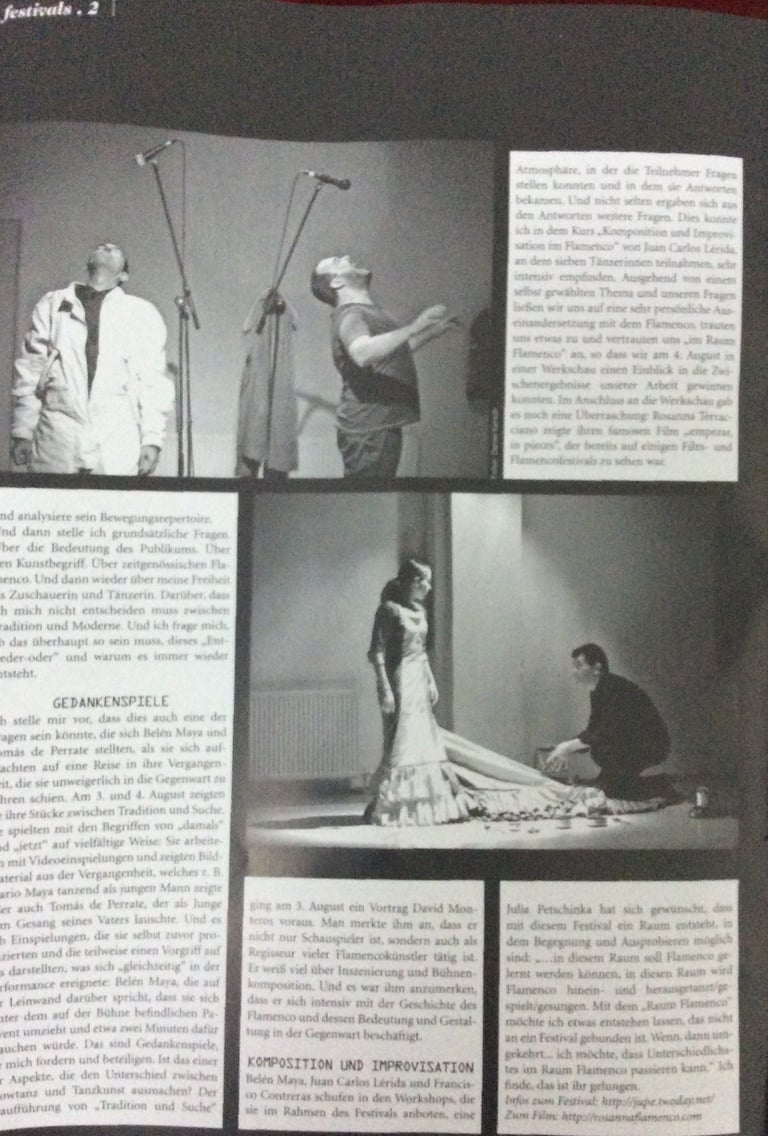

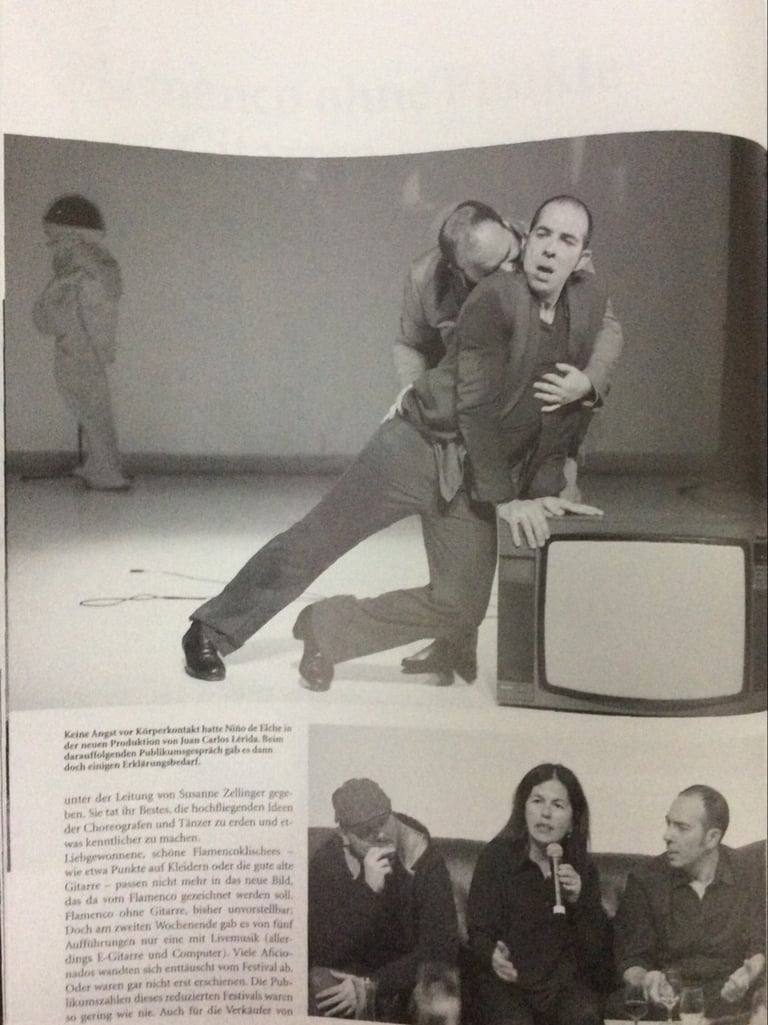

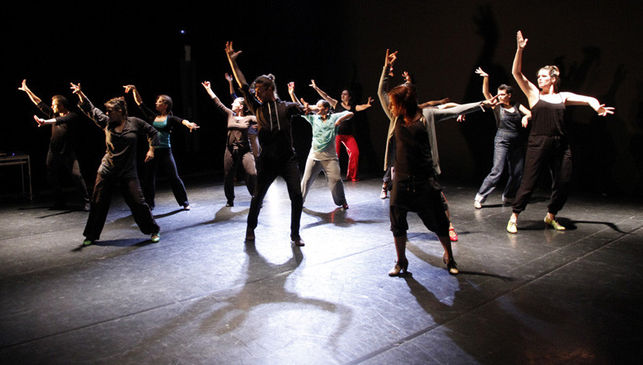


2012
FLAMENCO FESTIVAL LONDON
http://www.diariodesevilla.es/article/ocio/1483706/bailes/amarrados/la/estirpe.html


2010
BIENAL DE FLAMENCO SEVILLA 2010
CICLO FLAMENCO EMPÍRICO
12 May 2010 Text: Eva Vila Photos: Julia Petschinka
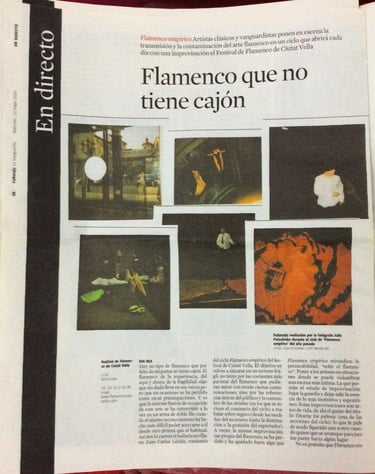

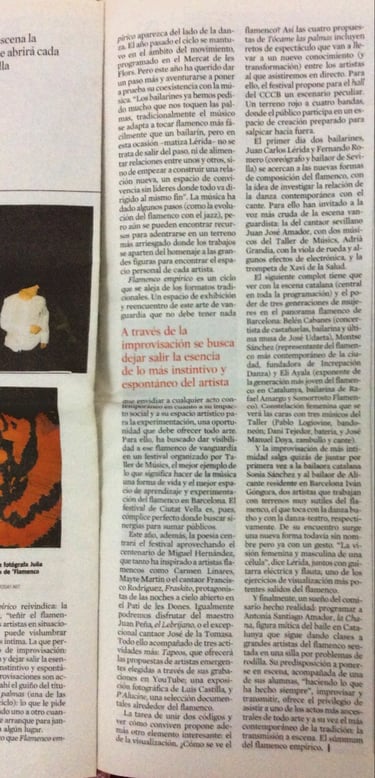


2007
ENGLISH TRASLATION.
New Flamenco,
The flamenco- festival at Düsseldorf’s tanzhaus nrw won’t inspire every flamenco fan with his focus on modern dance. The three dancers Andres Marin, Juan Carlos Lérida and Israel Galvan have a lot in common. Already as children they learned the orthodox flamenco in Sevilla, today in the middle of the thirties they barely count to the young wilds. For some they are considered as the visionary saviours, for others as the brutal destroyer of flamenco. All three have formed a distinctive style. They are open for experiments far beyond of flamenco clichés.
(…)
Also the play “El Arte de la Guerra » ( Art of war) of Juan Carlos, could be understanded as an impertinence. Lérida doesn’t go to war against the conventional flamenco, but it is too tight for him: “normal flamenco just knows two feelings: enjoyment and mourning”, he says. With his style of dance he brings agony, lust to kill, hate, depression and disgust on the stage. The flamenco aesthetics is also acoustically and optically deformed. No gorgeous coulisse, but a multimedia-based projection, no rose in the hair, but a camouflage suit, no guitars but electronics.
The audience has to take part: instead of applause, there is silent listenening.
Lérida twines in agony, dies in slow-motion, marches, begs, threats, dreams, bends himself, suffers visibly and is after 80 minutes completely weary. No member of the audience can elude from this horror-trip.
However does the flamenco- audience want to expose himself to such an artful experiment?
Or is the desire for clichés and doted dresses stronger? Always Flamenco stood on a fine line between kitsch and art. Through dance personalities like Marin, Galvan and Lérida there exists the best chances for the art today.
